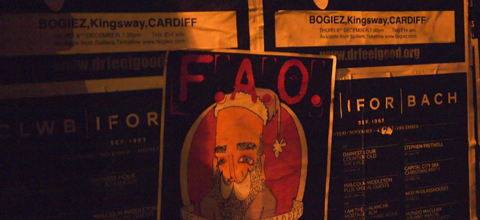Freedom of expression, or an urban blight?
A man dressed against the biting cold, his woollen hat pulled down low over his brow, stops by an abandoned shop front. The plywood is covered with posters. Some of them announce events that happened months ago; others have worn away completely, reduced to white flecks of paper. Quickly looking round he reaches into the bag at his side and draws out a rolled-up poster. Deftly unfurling it and holding it to the wall, he pulls out a brush and dips it into a plastic bag of paste. Within seconds the poster is up, and he moves on down the street.
In the age of Twitter and Facebook updates, flyposting may seem an antiquated communication method. But for countless record labels, nightclubs and political organisations, this illegal practice endures. Why is it so effective, and is criminalisation the right stance to take against it?
For those who do it, flyposting is a risky business; last month, Mountain Ash man Ceri Reardon was fined for illegally advertising his car wash. The law classes anything — from a sticker to a large banner – which does not have the permission of the Planning Authority, as a flyposter, and anyone found guilty of displaying, or benefitting from the display of one can be fined up to £2500 per offence.
Promoting nightlife
A Cardiff-based flyposter, who works for a club promoter, and who requested that his name not be used in this article, described how he goes about the task: “We do it anywhere students, young professionals pass and hopefully see the posters, which would be the city centre, the main bar districts, routes into town we know commuters pass. The promoter gives me about 30 quid, a pile of posters and a list of streets to do. It’s generally when the streets are busiest, so between four and seven. Posters get taken down or covered up very quickly, so you want the posters to be seen by the maximum amount of people in the shortest amount of time.”
These days, isn’t it easier — and cheaper — to simply tweet? “As much as social media is important in getting your message across, flyposters are still a massive way of promoting,” said the unnamed flyposter. “Because people do look out for nights on flyposters, and very few nights don’t use them. It is risky and it is quite expensive, compared to social media. But it must pay off, because promoters generally know what they’re doing.”
The council says that flyposters make areas look untidy, create litter and make street furniture uninviting or unusable. “They have a detrimental effect on the appearance of the locality and making an area look run down,” said a council spokesman. The city’s Waste Management division has received 19 requests, most of which came from the city centre and Plasnewydd areas, to remove fly posting in the past year, said the spokesman, at a total cost of around £600.
Freedom of expression?
While local authorities claim that flyposting amounts to vandalism-for-profit, many entrepreneurs and activists feel that banning the practice damages politics and culture.
Edmund Schluessel is secretary of Cardiff Against the Incinerator, a group opposed to waste incineration in Wales. The group have flyposted for meetings and demonstrations, and have also used it as a civil disobedience tactic. “When you make public space of any kind a commodity, it will end up being dominated by the rich, who will use it to make themselves richer,” he said. His group, he explained, need to appeal to older people – he points out that one in three people in Wales do not have internet access – and so posters are the most effective way of communicating their message. Perhaps the very act of posting appeals to the dissident spirit of radicals. “There is a bit of romantic cachet associated with it,” he said, “by taking a bit of public space and using it for your own purpose you’re at the bottom end of a spectrum where the current top would be the Occupy movement.”
Designing dissidence
To counter flyposting, the council provides a certain amount of free legal advertising space in the city – yet many of the city’s lampposts, benches and walls are often plastered with messages. Neil Angove lectures in Graphic Design at Cardiff School of Art and Design: “Perceived illegality, or visual intrusion, would either arouse disinterest, even annoyance – or would arouse interest, perhaps because a perceived counter-establishment or counter-cultural message appeals to its intended audience,” he said, explaining that, “Where such a message is also perceived as a lone-voice, calling out from an overwhelming crowd, or a call to challenge the status quo, the strength of that audience’s response may even be enhanced.”
Is it right that big companies effectively monopolise advertising in our cities? “One could argue that a profusion of flyposting is also a monopolisation,” said Neil, “Or, perhaps, any kind of print-based advertising despoils the urban environment.”
Like the constant stream of mass media that pervades our cities, it seems these crudely printed, furtively applied posters are here to stay.

